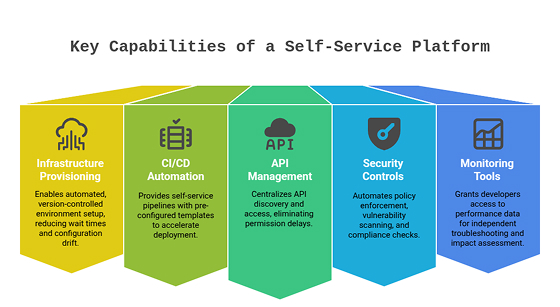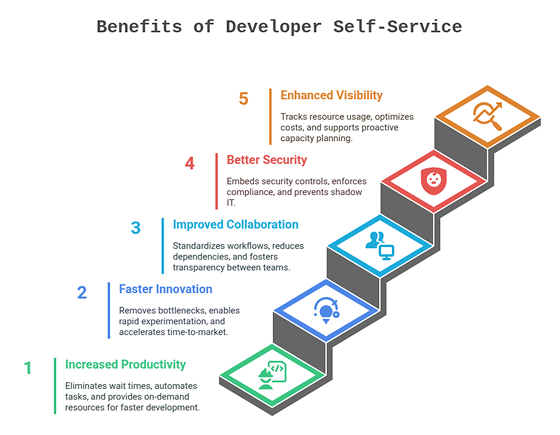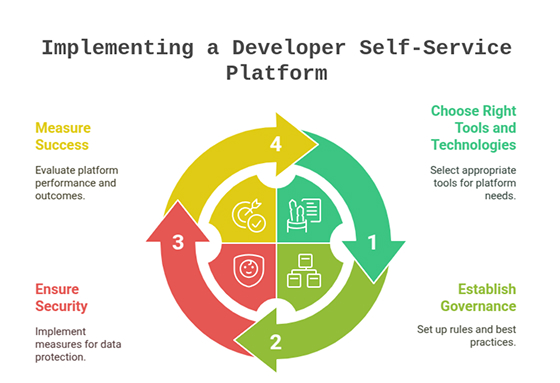Developer self-service is an approach that helps developers manage all the resources and tools to code, build, test, and deploy software without external help.
It removes the everyday problems that we have by provisioning infrastructure, environments, and services to developers on demand in fully automated platforms.
The importance of developer self-service
Developers frequently encounter frustrating roadblocks when they lack self-service capabilities.
They must submit a support ticket to their operations team, await approvals, and go through a gruesome process to provision an environment or make an infrastructure change. These dependencies on operations teams create significant bottlenecks that stall productivity and innovation.
As market demands drive ever-shorter development cycles, such traditional processes become increasingly untenable. Organizations face mounting pressure to accelerate delivery while maintaining quality, making the elimination of these operational dependencies through self-service platforms not just beneficial but essential for competitive survival.
Key capabilities of a self-service platform
In order for a platform to be self-service, certain aspects must be met. These are illustrated below.

1. Infrastructure provisioning (IaC)
- Enables developers to spin up environments through declarative templates.
- Ensures consistent, reproducible infrastructure that can be version-controlled.
- Eliminates wait times and configuration drift through automation.
2. CI/CD pipeline automation
- Provides self-service access to build, test, and deploy pipelines.
- Offers pre-configured templates and workflows for teams to implement CI/CD.
- Accelerates the path from code to production without specialized expertise
3. API and service access management
- Centralizes discovery, documentation, and secure access to services.
- Enables easy finding and utilizing of needed APIs.
- Removes wait times for permissions or authentication struggles.
4. Security and compliance controls
- Embeds guardrails directly into self-service workflows.
- Automates policy enforcement, vulnerability scanning, and compliance checks.
- Maintains security standards while preserving development velocity.
5. Observability and monitoring tools
- Delivers self-service access to performance data, logs, and metrics.
- Enables independent troubleshooting without relying on operations teams.
- It helps developers understand the real-world impact of their changes.
The self-service model in DevOps
Self-service transforms DevOps into a practical reality by removing traditional barriers between development and operations teams. It does this by:
- Establishing a frictionless bridge between development and operations.
- Providing developers with controlled autonomy within organizational guardrails.
- Creating an environment where DevOps principles can flourish beyond theoretical frameworks
- Enabling developers to independently provision infrastructure, configure pipelines, and access monitoring tools.
- Reducing handoff delays and eliminating the traditional “throw it over the wall” mentality.
These services are heavily used in the industry. In fact, Spotify uses backstage.io to provide standardized tools for service creation and management. On the other hand, Etsy enables developers to deploy directly to production through self-service pipelines with automated safety checks.
These tools have been widely adopted by many Fortune 500 companies around the world, showcasing their importance.
Benefits of developer self-service
Implementing developer self-service has multiple advantages beyond just speeding up development processes to fundamentally transform engineering efficiency and innovation potential.
Some of these key benefits are discussed below:

1. Increased engineering productivity
- Eliminates waiting time for resource provisioning and approvals.
- Automates repetitive tasks, allowing focus on valuable development work.
- Creates standardized environments that minimize troubleshooting time.
2. Faster innovation and time-to-market
- Shortens deployment cycle time by removing operational bottlenecks.
- Enables rapid experimentation with new technologies and approaches.
- Accelerates feedback loops for continuous improvement.
3. Improved collaboration between teams
- Creates shared platforms and tools that standardize workflows.
- Establishes clear boundaries and interfaces between teams.
- Reduces dependencies while maintaining necessary communication.
4. Better security and governance
- Embeds security controls directly into developer workflows.
- Enforces compliance requirements automatically and consistently.
- Reduces shadow IT by making approved solutions easily accessible.
5. Enhanced visibility and cost management
- Enables transparent tracking of all infrastructure and resource consumption.
- Allows leadership to identify optimization opportunities for underutilized resources.
- Supports proactive capacity planning based on actual usage metrics.
Implementing a developer self-service platform
Implementing an effective developer self-service platform requires thorough strategic planning and thoughtful architectural decisions to ensure long-term success.
The steps that would need to be taken to establish a developer self-service platform are showcased below:

1. Choosing the right tools and technologies
- Assess current development workflows and identify major friction points.
- Select platforms that integrate with the existing technology ecosystem.
- Prioritize tools with robust APIs and automation capabilities.
- Balance comprehensive functionality with ease of use and maintenance.
2. Establishing governance and best practices
- Define clear service ownership and responsibility boundaries.
- Create standardized templates and golden paths for common workflows.
- Document self-service capabilities comprehensively with examples.
- Implement a progressive rollout strategy starting with pilot teams.
3. Ensuring security and compliance
- Integrate security scanning and compliance checks into self-service workflows.
- Establish clear audit trails for all self-service actions.
- Define appropriate approval workflows for high-risk operations.
- Create secure credential management with proper access controls.
4. Measuring success and continuous improvement
- Monitor essential metrics such as deployment frequency, lead time, MTTR, and change failure rate.
- Evaluate resource use and improvements in operational efficiency.
- Make continuous adjustments based on user feedback and evolving needs.
- Consistently compare performance with industry standards and competitors.
Challenges and considerations
Developer self-service offers game-changing benefits, but several obstacles exist when establishing it within an organization, including:
- Balancing autonomy with governance and security requirements.
- Ensuring quality control without creating bottlenecks.
- Managing the costs of decentralized resource provisioning.
- Developing standardized templates and frameworks.
- Ensuring consistent compliance across teams.
- Scaling solutions as the organization grows.
- Integrating with existing tools and workflows.
Concluding thoughts
Developer self-service gives teams direct control through autonomous resource access. It balances speed and governance while eliminating delays and maintaining standards.
Organizations using self-service can gain innovation speed, developer experience, and operational efficiency advantages.
I hope you found this guide helpful.
Thank you for reading.
